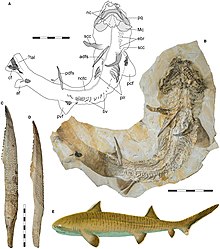Asteracanthus
| Asteracanthus Temporal range:
| |
|---|---|

| |
| Complete skeleton and restoration of Asteracanthus ornatissimus from the Solnhofen Limestone | |
| Scientific classification | |
| Kingdom: | Animalia |
| Phylum: | Chordata |
| Class: | Chondrichthyes |
| Superorder: | Selachimorpha |
| Order: | †Hybodontiformes |
| Family: | †Hybodontidae |
| Genus: | †Asteracanthus L. Agassiz, 1837 |
Asteracanthus (from Greek: ἀστήρ aster, 'star' and Greek: ἄκανθα akantha, 'spine')[1] is an extinct genus of hybodontiform, known from the Triassic-Cretaceous of Europe, North America, Asia and Africa.[2]
Description[]
Astercanthus was among the largest known hybodontiformes, reaching a length of 2-3 metres. The dentition of Astercanthus is high crowned and multicusped.[3]
Fossil records[]

This genus has been reported from the Middle Triassic to the Cretaceous, though the genus as currently circumscribed dates from the Bathonian-Valanginian, predominantly of Europe[3] Fossils are found in the marine strata of United States, Iran, Switzerland, Madagascar, Marocco and Europe. A complete skeleton was described in 2021 from the Late Jurassic (Tithonian) aged Solnhofen Limestone.[3] Previously considered synonymous, the genus (Middle Triassic-Late Cretaceous) is now considered distinct, with the teeth of Asteracanthus having more in common with Hybodus and .[3]
Life habits[]
The genus seems to have been adapted for open marine conditions and likely had an epibenthic habit.[3]
Species[]
Species within this genus include:[4]
- Asteracanthus acutus Agassiz 1837
- Asteracanthus aegyptiacus Stromer, 1927[5]
- Asteracanthus granulosus Egerton 1854
- Asteracanthus magnus Agassiz 1838
- Asteracanthus medius Owen 1869
- Asteracanthus minor Agassiz 1837
- Asteracanthus ornatissimus Agassiz 1837
- Asteracanthus papillosus Egerton 1854
- Asteracanthus semisulcatus Agassiz 1837
- Asteracanthus siderius Leidy 1870
- Asteracanthus somaensis Yabe 1902
- Asteracanthus tenuis Agassiz 1838
- Asteracanthus udulfensis Leuzinger et al. 2017[6]
References[]
- ^ Roberts, George (1839). An etymological and explanatory dictionary of the terms and language of geology. London: Longman, Orme, Brown, Green, & Longmans. p. 12. Retrieved 29 December 2021.
- ^ Woodward, Arthur Smith (2014). "The Fossil Fishes of the English Wealden and Purbeck Formations". doi:10.1017/CBO9781139680851.
{{cite journal}}: Cite journal requires|journal=(help) - ^ a b c d e Stumpf, Sebastian; López‐Romero, Faviel A.; Kindlimann, René; Lacombat, Frederic; Pohl, Burkhard; Kriwet, Jürgen (2021-01-13). Cavin, Lionel (ed.). "A unique hybodontiform skeleton provides novel insights into Mesozoic chondrichthyan life". Papers in Palaeontology: spp2.1350. doi:10.1002/spp2.1350. ISSN 2056-2799.
- ^ Paleobiology Database
- ^ Ibrahim, Nizar; Sereno, Paul C.; Varricchio, David J.; Martill, David M.; Dutheil, Didier B.; Unwin, David M.; Baidder, Lahssen; Larsson, Hans C. E.; Zouhri, Samir; Kaoukaya, Abdelhadi (2020-04-21). "Geology and paleontology of the Upper Cretaceous Kem Kem Group of eastern Morocco". ZooKeys. 928: 1–216. doi:10.3897/zookeys.928.47517. ISSN 1313-2970. PMID 32362741.
- ^ Léa Leuzinger; Gilles Cuny; Evgeny Popov; Jean-Paul Billon-Bruyat (2017). "A new chondrichthyan fauna from the Late Jurassic of the Swiss Jura (Kimmeridgian) dominated by hybodonts, chimaeroids and guitarfishes". Papers in Palaeontology. 3 (4): 471–511. doi:10.1002/spp2.1085.
- L. Agassiz. 1837. Recherches Sur Les Poissons Fossiles. Tome III (livr. 8–9). Imprimérie de Petitpierre, Neuchatel viii-72
- Hybodontiformes
- Triassic fish of Europe
- Permian fish of North America
- Devonian first appearances
- Cretaceous extinctions
- Devonian sharks
- Carboniferous sharks
- Permian sharks
- Triassic sharks
- Jurassic sharks
- Cretaceous sharks
- Prehistoric shark genera
- Fossil taxa described in 1837
- Taxa named by Louis Agassiz
- Jurassic fish stubs
- Cretaceous fish stubs